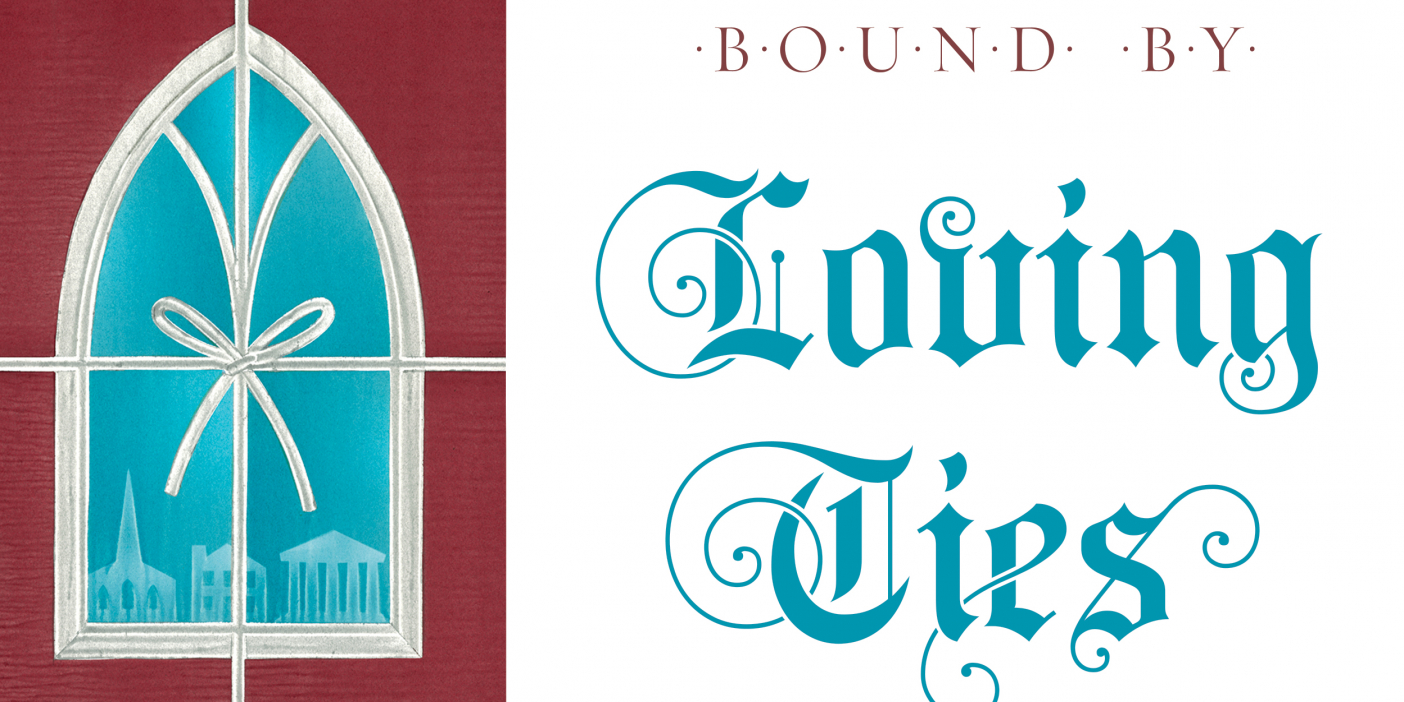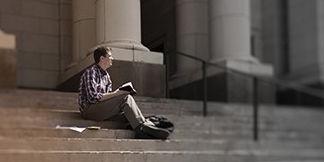Four BYU Mementos
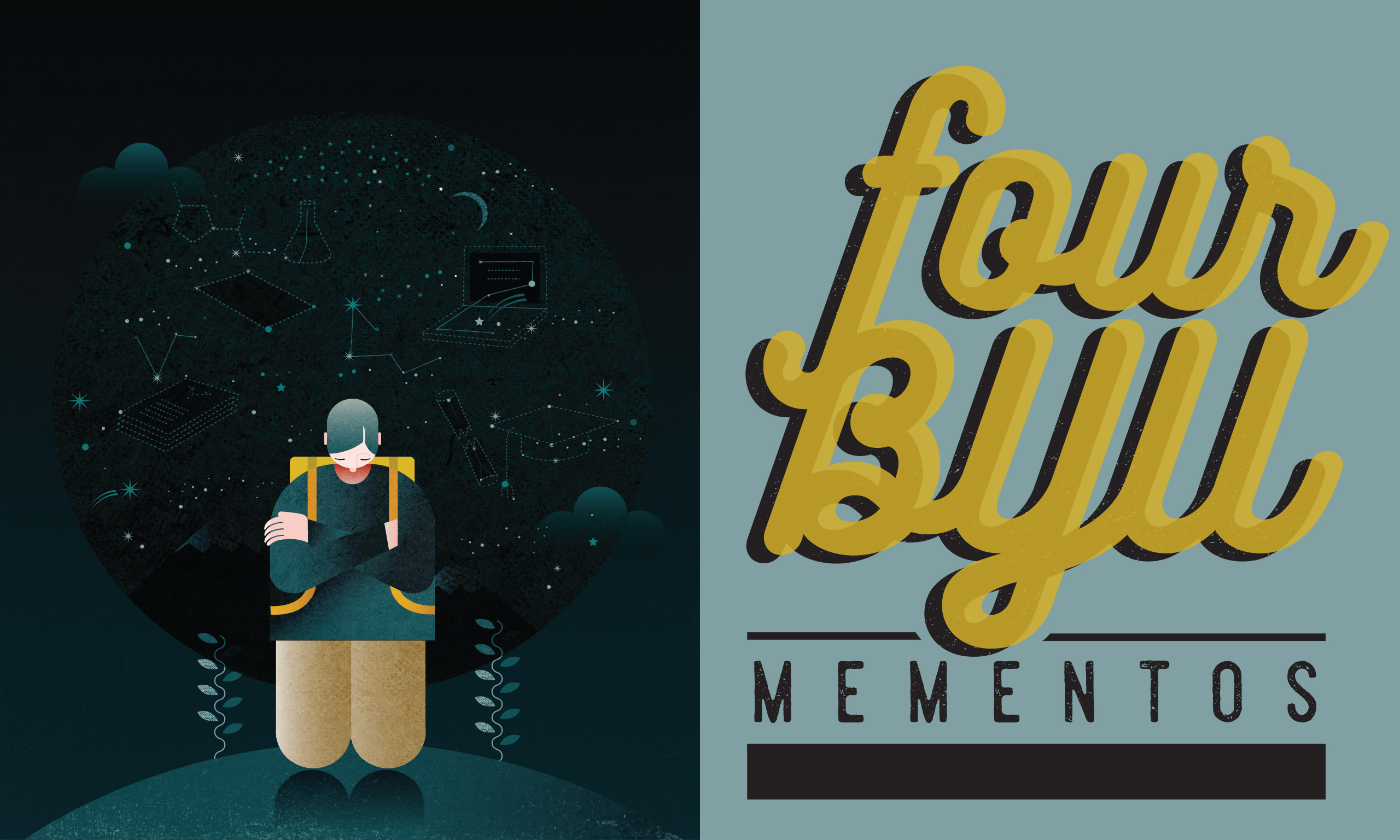
Reminders help me stand up straight, smile, and remember who I am.
By Matthew O. Richardson (BA ’87, MEd ’90, EdD ’96) in the Spring 2017 Issue
Illustrations by Gloria O. Pak (BFA ’10)
Over the past several decades, my wife, Lisa Jackson Richardson (BA ’87), faithfully stood at our door to send our children off for school. Without exception, she would call to them—usually in her pajamas—and say, “Stand up straight, smile, and remember who you are! You’re a Richardson, a child of God!” Then she’d proceed to recite our family motto and cap it all off with an enthusiastic “Be a light!”
After our children heard this charge nearly every day of their young lives, is it any wonder that this ritual has been forever engrained in their memories—and in the memories of their friends and quite possibly of our neighbors?
With this image fresh in your mind, I would like to focus on the first part of my wife’s simple but profound instruction: “Stand up straight, smile, and remember who you are.”
President Ezra Taft Benson once said, “It is our privilege to store our memories with good and great thoughts and bring them out on the stage of our minds at will.”¹ There is great power in knowledge, but it seems that there is even greater power in remembering. President Spencer W. Kimball once asked, “When you look in the dictionary for the most important word, do you know what it is?”
He then answered, “It could be remember.” He also said, “Our greatest need is to remember,” and emphasized, “remember is the word. Remember is the program.”²
It is not unusual for people to use strategies or objects to help them remember things that are important. Everyone knows about tying a string around one’s finger. Others use rhyming patterns, flash cards, repetition, or other devices to create, categorize, or even trigger a memory. Some people save mementos. More than just a keepsake or a souvenir, a memento is an object with the purpose of helping one to remember. In fact, the word memento comes from Latin, in which it is the imperative form of the word remember.
BYU has impacted my ability to stand up straight, has influenced why I smile, and has greatly molded who I am today. I have been privileged to be part of this university as a student, a professor, and now an administrator for more than three decades.
There are certain things about my BYU experience that I earnestly hope I will never forget.
I would like to share four personal BYU mementos that continue to help me in my quest to stand up straight, smile, and remember who I am.
A Chemistry 105 Exam
One treasured memento from my BYU past is a Chemistry 105 exam. Of all the hundreds of papers, quizzes, and exams from my undergraduate experience, this is the only academic memento I have saved.
I vividly remember watching the professor hand a big stack of exams to the person on the front row and say, “Find your exam and pass the pile along.” This was long before FERPA laws protected privacy, so public humiliation or adoration (depending on how you performed) was always a looming possibility. I hastily retrieved my exam and hurried out of class for home.
As I walked out of the building, I glanced at the exam and saw the number 76 scrawled across the top in red pen. I felt as if someone had punched me in the stomach. I quickly stuffed the exam into my backpack. My mind raced, and I started thinking that obviously I wasn’t smart enough to be at BYU, for surely everyone else in the class had scored much higher than I had.
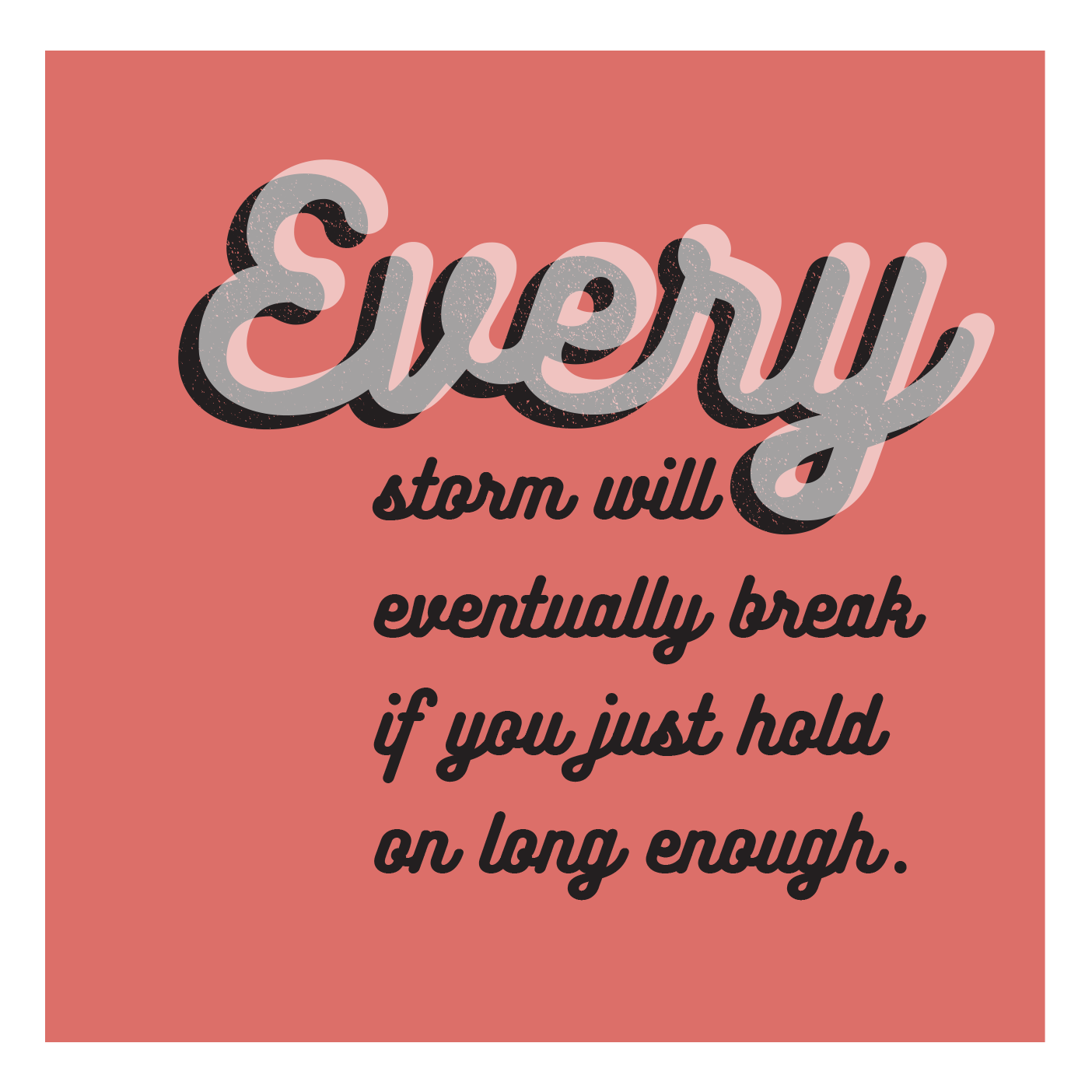
The number 76 kept flashing over and over in my mind as I walked down the stairs south of campus leading to the Botany Pond. Nearing the bottom of the stairs, I pulled the dreaded exam from my backpack, hoping that somehow I had read my score incorrectly. But sure enough, that red 76 was still there.
Then I saw something I hadn’t noticed before—a tiny minus sign. You see, I didn’t get a 76 on this exam, I missed 76! And sure enough, in the corner was my actual score—24! Surely this is the lowest score in BYU history given to someone who actually tried to do well.
Now you may wonder why in the world I’d save that particular exam as the only memento of my BYU undergraduate academic experience.
I saved it because this experience impacted and shaped me in significant ways—ways I hope never to forget. I am not proud of failing—or of failing with such absolute certainty. What happened next, however, was something I hope I will always remember. Somehow I resisted the urge to pack all my belongings into my car, drive home, and leave BYU and all my humiliation in the rearview mirror. It was during this time that I came across a quote that read, “Success is not final, failure is not fatal: it is the courage to continue that counts.”³
I occasionally look at that exam and remember that every storm will eventually break if you just hold on long enough. I remember that learning is a process and not an event and that I can do difficult things, even when it takes more time than I have and additional strength and effort. Most important, I am reminded that life is not determined by a singular performance and that there are times when we need, as my wife so eloquently taught our children, to remember who we are and to stand up straight—no slouching, no shrinking, no wilting. Just stand up straight, smile, and remind yourself that you have the courage to continue.
Half a Degree
My next memento came from my graduate studies at BYU several years later. Upon receiving my master’s degree, we held a family celebration. As I was running out of our home to the party with my new degree in hand, I had an epiphany. Without thinking, I went to the workbench and cut my degree in half. I drove to the party, walked in the door, and handed my wife half of my degree.
She looked somewhat stunned and asked, “What’s this?”
“It’s my master’s degree!” I said.
“You sawed your degree in half?” she asked incredulously.
The look on her face and the sound of her voice caused me to realize that this might not have been one of my better ideas. I explained that even though the degree had my name on it, it was just as much hers as it was mine. She had worked just as hard as I had and deserved at least half of the credit.
“But you cut it in half?” she said again.
Now why would I keep half a degree on my shelf? Because I always want to remember that everything worthwhile comes with the help of others. Life is a collaborative endeavor, and success—genuine success—is attributable to a lot more people than just you.
So please ask for help. Look for support. Seek for those who will cheer you on, support you, celebrate with you, and even push you to be more than you are at the moment. Be that person for others.
Karl G. Maeser used to tell the students of Brigham Young Academy, “Be yourself, but always your better self.”⁴ I feel we need more Karl G. Maesers in our life. We need to smile more, encourage more, and help one another more.
Foundational Documents
Every fall I read the BYU foundational documents, a compilation of talks about BYU, who we are, and who we must become—so that I will never forget that at the core of this university are revelations, dreams, and visions.
I would like to highlight one particular story. In 1915 BYU was in dire financial difficulties and was preparing to sell the very land on which our campus now stands. The commencement speaker, a student named Alfred Kelly, was given an assignment to promote selling the property in his speech, but the idea troubled him. Early one morning he walked to the land that was to be sold. He prayed, and then it happened: he saw what he called a “strange vision” with “thousands of young people who approached me, their arms laden with books.” Kelly continued:
I turned around to find the area behind me illuminated as well. In that light I saw hundreds of buildings, large and beautiful temples of learning. Those young people passed by me and entered in. Then, with cheerfulness and confidence, they turned toward the east and lifted their eyes heavenward, where, again becoming part of the sunlight, they gradually disappeared from my view.⁵

He decided to share this experience in his commencement speech instead of promoting the land sale. He then sat down, and everyone was silent. I have always loved how Elder Jeffrey R. Holland (BS ’65, MA ’66), when he was BYU president, told what happened next:
Longtime BYU benefactor Jesse Knight jumped to his feet and shouted, “We won’t sell an acre. We won’t sell a single lot.” And he turned to President George Brimhall and pledged several thousand dollars to the future of the university.⁶
Why was Alfred Kelly’s vision of BYU’s future so important? Was it simply needed to inspire and motivate those like Jesse Knight to invest in BYU with confidence and to ensure its future? Was the ultimate goal only to ensure that degrees would be awarded, jobs secured, and LinkedIn contacts amassed? It is true that Kelly’s vision did describe thousands of young people laden with books entering into large and beautiful buildings. It showed that this educational enterprise was all going to work out in the end.
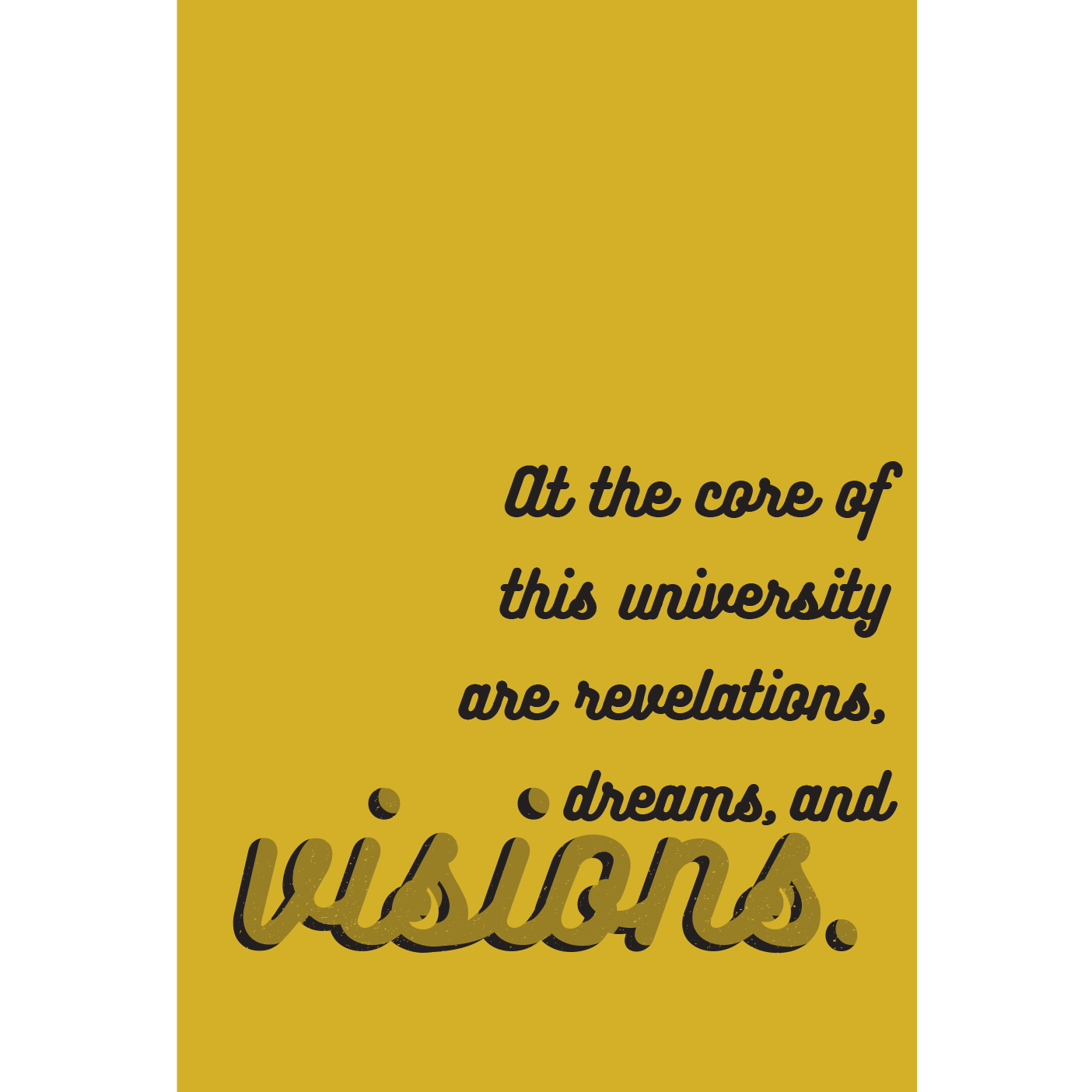
But I believe Alfred Kelly’s vision did much more than just save the campus. I believe it also defined our campus. Alfred Kelly not only saw future buildings but purposefully described them—as Karl G. Maeser had earlier⁷—as “temples of learning.” And this was not all. Those temples of learning were illuminated by light. Sixty years later President Spencer W. Kimball said that all subject matter at BYU should be “bathed in the light and color of the restored gospel.”⁸
More than just buildings and a campus, Alfred Kelly saw future BYU students coming out of those temples of light “with cheerfulness and confidence,” who “turned toward the east and lifted [their] eyes heavenward.”
I love this imagery. If you stand on campus and turn to the east, what do you see? The mountains. In his inaugural address, President Kevin J Worthen (BA ’79, JD ’82)taught that “mountains are places of spiritual communication and revelation.” He also explained that “mountains are . . . locations where people can be enlightened, uplifted, and changed.”⁹ BYU is nestled in a revelatory setting unlike any other, and the very posturing of students described by Alfred Kelly with their eyes lifting heavenward evokes in my mind images of other learners, such as Joseph Smith in a grove of trees.
Finally, it must not be lost on us that Alfred Kelly was a student at the time of his impactful vision. It is rather astounding to think that such a dream was had by a visionary student about future visionary students! Every time I read BYU’s foundational documents I am reminded that this place is a place of revelation and vision.
John S. Tanner (BA ’74), former BYU academic vice president, once said: “Over the years thousands of individuals have contributed to the dream of BYU. Every year new students and faculty add their particular hopes and dreams to our collective vision.”¹⁰ Thus all of us must continue seeking enlightenment, pursuing revelation, and dreaming dreams for our own futures and the future of this university.
You Gotta Believe
Let me present one last personal memento from my BYU experience. Every computer I have owned for the past 29 years has had the same screen saver. It is a custom message that reads, “You gotta believe.” This memento helps me recall something I hope to always remember.
At the beginning of my senior year at BYU, I began worrying whether I was making the right decision about my future. I was taking entrance exams for graduate programs and even submitting applications, but nothing felt right. To find some guidance, I interviewed doctors, lawyers, businessmen and women, teachers, and pretty much everyone who had a pulse. Nothing clicked. Lisa and I started fasting and praying for direction. Nothing happened. We kept on praying and fasting.
One day in the fall Lisa asked me if there was anyone who could possibly help me with whom I hadn’t yet already talked.
Without a moment’s hesitation, I said, “Yes. If I could only talk to the president of BYU, Jeffrey R. Holland, that would clear everything up.”
So Lisa, who possesses more passion, compassion, and faith than Joan of Arc, Mother Teresa, and Esther of the Old Testament combined, said, “Then you should go and talk with him!”
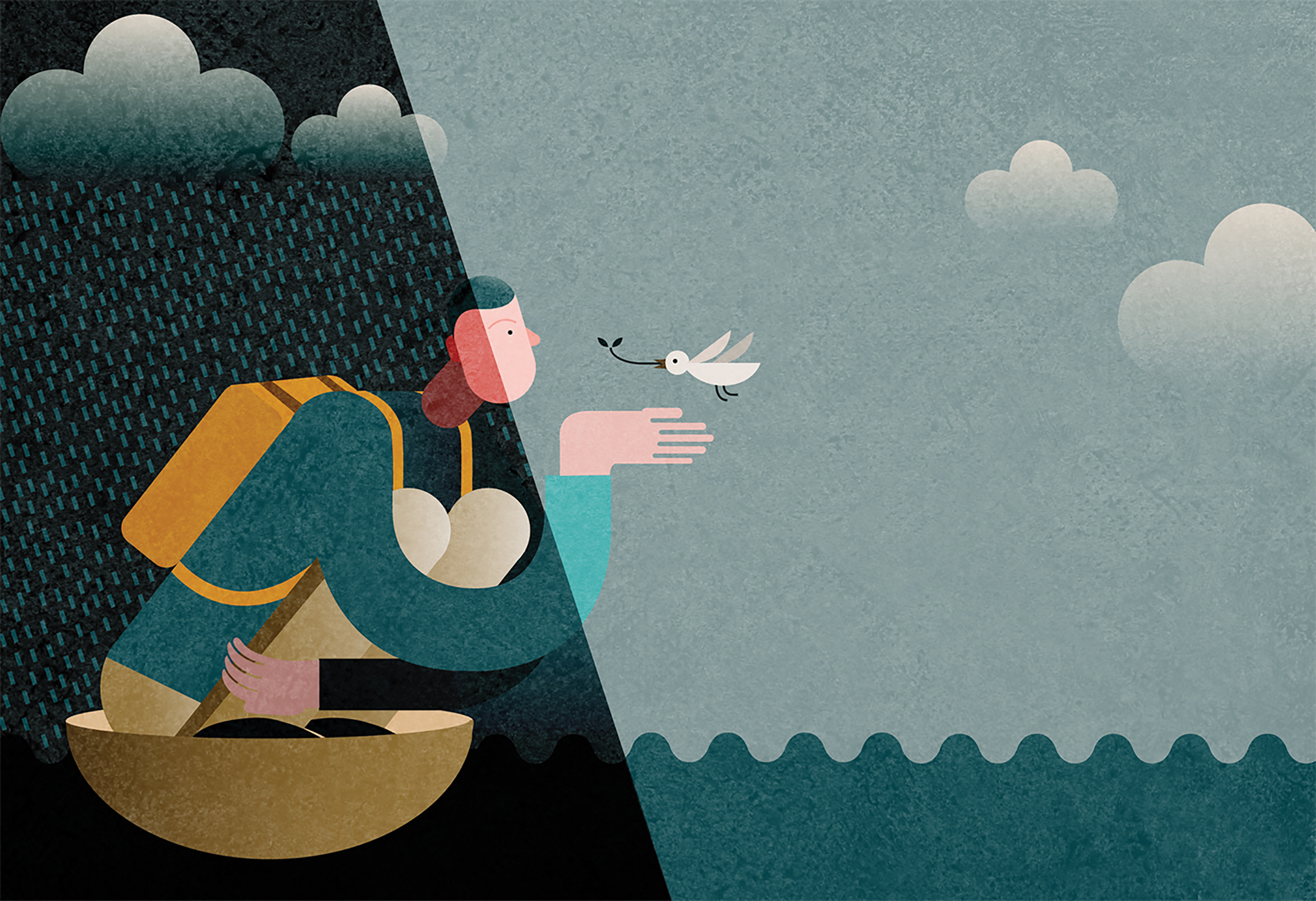
“Are you crazy?” I thought. What would I say? “Um, excuse me, President. I am one of the 30,000-plus students at BYU. Will you please tell me what I should do with my life?”
Instead, I muddled my way through the next seven or so months trying to figure it out. But I couldn’t seem to get my bearings. I felt as if I were in a fog. It felt as if everyone but me was receiving revelation, direction, and confidence.
When it seemed to matter the very most, I felt a little alone—abandoned and even hopeless at times. I reached a point in which I didn’t care so much about what I did for a living as much as I cared about receiving divine direction. I wasn’t standing up very straight, my hands were hanging down, and my feeble knees needed strengthening (see D&C 81:5).
Just a few weeks prior to graduation, I attended my senior capstone class in the basement of the Jesse Knight Building. As I prepared to leave the building, I noticed a crowd gathered at the west doors. I worked my way to the front and discovered the reason no one was leaving: there was a complete downpour. Having taught at the MTC earlier that day, I was dressed in a suit. I can almost hear myself saying, “Typical, just typical,” as I sized up the situation.
I put a Daily Universe newspaper over my head and started running through the parking lot. The newspaper turned to a pulpy mush, and I was soaked almost immediately. So I walked—slowly.
“I might as well catch pneumonia and be sent to the hospital,” I thought. I was in a blue mood.
As I walked past the Brimhall Building, I heard someone yell out to me.
I looked across the street, and there was President Holland at his car holding up an umbrella. He opened the rear passenger door and offered me a ride home. I ran across the street, got in, and immediately created a puddle of water on the backseat. Sister Holland, already in the car, greeted me as President Holland got into the driver’s seat.
“Where can I take you?” President Holland asked, looking at me through the rearview mirror.
My wife and I were managing apartments south of campus, and I hesitated telling him where I lived because I didn’t think he would be very impressed. But with the president of the university looking me in the eye, albeit through the rearview mirror, I confessed the name of the complex.
President and Sister Holland chuckled, and President Holland said, “Pat and I managed those apartments when we were undergraduates at BYU.”
I was stunned and speechless. I couldn’t comprehend that President Jeffrey R. Holland had actually lived in the same apartments I was living in. Impossible! You see, I had long admired President Holland and had placed him and Sister Holland in the “Born with a Life” category. I imagined that his life was charmed. He had been a perfect high school athlete, had been a perfect missionary, and had a perfect wife. So to think that I actually lived in the same apartments was incomprehensible.
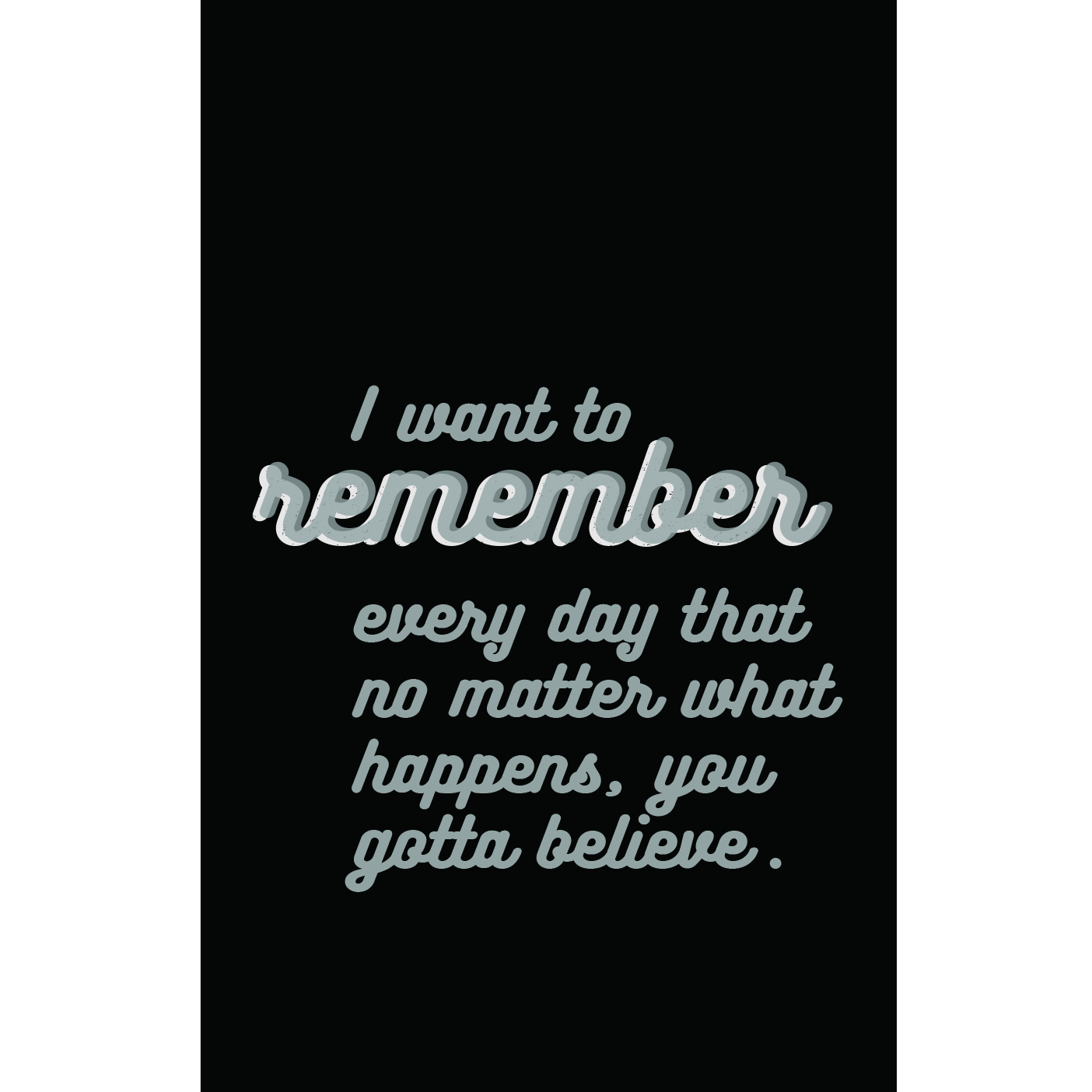
“Are you married?” they asked.
“Yes,” I answered, my head still spinning.
“Do you have children?”
“We have a son,” I said.
“Our first son was born while we were in those apartments,” they explained.
“Really?” I managed to blurt out.
As we drove south on Campus Drive past the Maeser Building, I suddenly remembered telling my wife that if I could only talk with President Holland, then I was confident I would receive helpful direction. I mustered my courage and asked, “Did you ever worry about your future?”
“Oh yes,” he replied.
I was stunned, and all I could say was, “Really?” After all, I thought this was a man who had never had a worry in his entire life.
At each response to my questions, I repeated, “Really?”
I finally asked, “President Holland, have you ever been so discouraged that you didn’t know if things would ever work out? Did you ever worry that you might not make it after all?”
He looked at me through the rearview mirror and answered, once again to my surprise, “Yes, I did.”
True to the pattern of our conversation, I managed an incredulous “Really?”
I recall Sister Holland saying, “Yes, Matt. Really.”
We drove to my complex, and I moved toward the door to get out. But President Holland put the car in park, and he and Sister Holland turned in their seats to face me. We talked.
At one point he said, “Matt, part of your problem is that you don’t believe.”
I admit I felt a little bad, as if my testimony was considered subpar.
“Oh, I’m not talking about your testimony,” President Holland said. “You just believe that God will work His mighty miracles for everyone but you.”
He was right.
And then he said with his typical fervor, “You gotta believe, Matt. You gotta believe.”
He offered me sound counsel and heaps of encouragement, and then I got out of the car. I stood and waved until they were out of sight.
Upon entering our apartment I shared my experience with Lisa. We wept together and then wrote the experience down—so that we would always remember.
So why the screen saver? I never want to forget that God is aware of each us. I want to remember every day that no matter what happens, you gotta believe.
Many years after my ride home in the rainstorm, Elder Holland, in a general conference address, reflected on a personal experience when he was discouraged and unsure about his own future. He offered himself this advice, which brought back memories and renewed my own resolve. Elder Holland said:
Don’t give up, boy. Don’t you quit. You keep walking. You keep trying. There is help and happiness ahead—a lot of it—30 years of it now, and still counting. You keep your chin up. It will be all right in the end. Trust God and believe in good things to come.¹¹
I realize that your BYU mementos may not be exactly like mine. I am confident, however, that they are probably similar, at least in principle. I testify that as challenging as it may seem, with faith and diligence, you can find the courage to continue. I testify that if you seek help and invite others into your life, then your life will be fuller, your success will be more meaningful, and you will find peace. I testify that God will answer your prayers. It may take months, years, or however long is required for you to receive His answers, but the vision will surely come. You gotta believe!
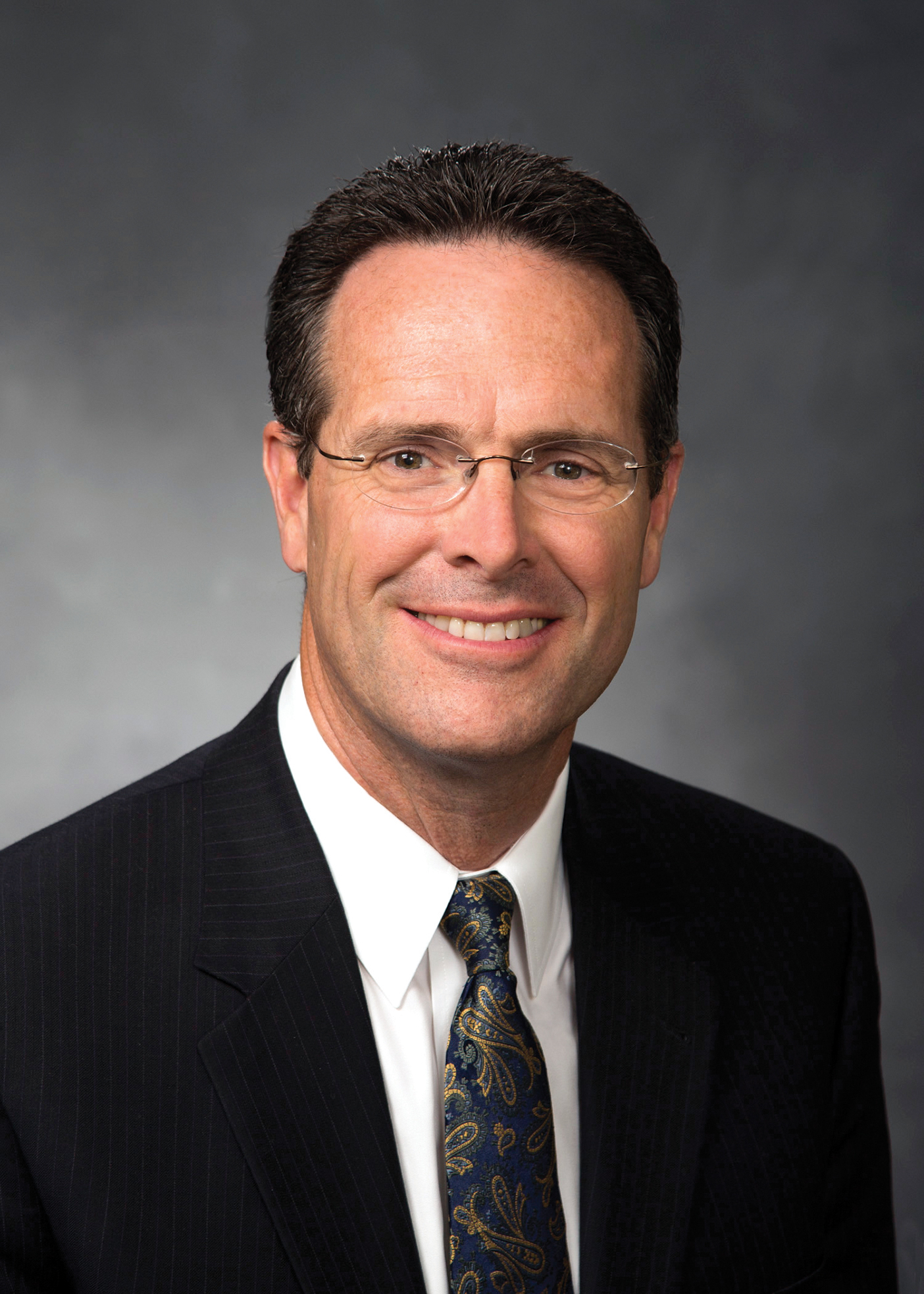
Matthew O. Richardson, BYU advancement vice president, delivered this devotional address on Oct. 25, 2016. The full text and video of the address are available at speeches.byu.edu.
Feedback: Send comments on this article to magazine@byu.edu.
NOTES
- Ezra Taft Benson, Come unto Christ (Salt Lake City: Deseret Book, 1983), p. 41.
- Spencer W. Kimball, “Circles of Exaltation,” BYU summer school devotional address, June 28, 1968, p. 8.
- Attributed to Winston Churchill; see Richard M. Langworth, ed., Churchill by Himself: The Definitive Collection of Quotations (New York: PublicAffairs, 2011), p. 579.
- Karl G. Maeser, in “Sayings of Dr. Karl G. Maeser,” Dr. Karl G. Maeser Memorial, special edition of Brigham Young University Quarterly 3, no. 3 (Feb. 1, 1907).
- In John S. Tanner, “House of Dreams,” BYU annual university conference address, Aug. 28, 2007; from B. F. Larsen, “Fifty Years Ago,” speech given at a BYU alumni meeting, May 25, 1962, B. F. Larsen biographical file, BYU Archives, p. 3–5.
- Jeffrey R. Holland, “Who We Are and What God Expects Us to Do,” BYU devotional address, Sept. 15, 1987.
- See Brigham Young University: The First One Hundred Years, eds. Ernest L. Wilkinson and Leonard J. Arrington, vol. 3 (Provo: Brigham Young University Press, 1976), p. 3.
- Spencer W. Kimball, “Education for Eternity,” pre-school address to faculty and staff, Brigham Young University, Sept. 12, 1967.
- Kevin J Worthen, “Enlightened, Uplifted, and Changed,” address at his inauguration as president of BYU, Sept. 9, 2014.
- Tanner, “House of Dreams.”
- Jeffrey R. Holland, “An High Priest of Good Things to Come,” Ensign, November 1999.



